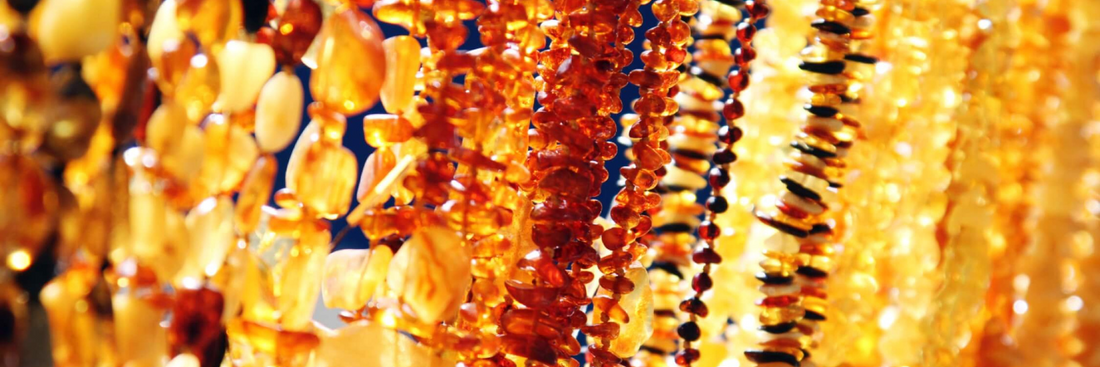Today, we're diving into the fascinating world of amber. Ever wondered what amber is, how it forms, and why it’s so prized? Let’s find out what it is and where it comes from.
What is Amber?
Amber is a naturally occurring fossilised tree resin, often celebrated for its golden hues and its ability to preserve ancient life forms. This gemstone has captivated humans for thousands of years, not just for its beauty but also for its mysterious origins and unique properties.
The Formation of Amber
The journey of amber begins millions of years ago. Certain trees, when damaged, secrete resin as a protective mechanism. This resin can harden and fossilise over millions of years under specific conditions, such as being buried under layers of sediment. Through this process, the resin transforms into the amber we treasure today.
The best-known sources of amber are found around the Baltic Sea, but significant deposits also exist in the Dominican Republic, Mexico, and even Australia. Baltic amber, in particular, is famous for its high quality and age, dating back about 44 million years.
Different Types of Amber
Amber comes in a variety of colours, the most common being golden yellow. However, it can also be found in shades of brown, red, green, and even blue. The colour and clarity of amber can be influenced by the presence of air bubbles, plant material, or other inclusions trapped within the resin as it fossilised.
- Baltic Amber which is found in the northern regions of Europe in particular Poland and Lithuania supplies up to 90% of the world’ This is the most prevalent type and is known for its rich, golden hues.
- Dominican Amber comes from the north and east areas of the Dominican Republic. Often clearer than Baltic amber and sometimes exhibits a rare blue fluorescence.
- Mexican Amber is found from fossil bearing rocks in the Simojovel region of Chiapas , Mexico. Known for its deep, rich colours, often containing a higher concentration of inclusions.
- Australian Amber has been found along the beaches of Far North Queensland , this type is relatively rare and valued for its unique characteristics.
The Inclusions of Amber
One of the most fascinating aspects of amber is its ability to trap and preserve ancient life forms. These inclusions can include insects, spiders, plant material, and even small vertebrates. These snapshots of prehistoric life provide invaluable insights into the ecosystems of the past.
The presence of these inclusions not only adds scientific value but also enhances the beauty and uniqueness of each piece of amber. It's like holding a tiny, ancient time capsule in your hand.
Historical and Cultural Significance of Amber
Amber has been used throughout history for various purposes, from jewellery and amulets to medicinal and ritualistic objects. The ancient Greeks and Romans prized amber for its beauty and believed it had protective and healing properties. The Greeks called it "elektron," associating it with the sun and its warm, glowing appearance
In many cultures, amber was believed to ward off evil spirits and bring good luck. It was also used in traditional medicine to treat ailments ranging from headaches to arthritis. Today, while some of these beliefs persist, amber is primarily valued for its aesthetic and scientific significance.
Amber in Modern Times
In contemporary jewellery, amber is a popular choice due to its warm, natural beauty and the uniqueness of each piece. Amber jewellery ranges from simple classic beaded amber necklaces to designs set in silver or gold, beaded amber bracelets, amber earrings in various shapes and sizes, amber rings, amber pendants, amber anklets, bracelets, and necklaces for children also amber collars for pets. The versatility of amber allows for a wide range of styles, making it suitable for both everyday wear and special occasions.
Beyond jewellery, amber is also used in decorative items, such as carvings and beads. Its ability to be carved and polished makes it a favourite among artisans and collectors alike.
The Science Behind Amber
From a scientific perspective, amber is a window into the past. Paleontologists and geologists study amber to understand ancient ecosystems and climate conditions. The inclusions within amber provide a wealth of information, often revealing species that are long extinct and offering clues about the evolution of life on Earth.
Amber’s preservation of DNA has even opened up possibilities for genetic research, although the popular notion of cloning dinosaurs à la "Jurassic Park" remains within the realm of science fiction
How to Care for Amber
Amber is relatively soft compared to other gemstones, ranking around 2-2.5 on the Mohs hardness scale. This means it can be scratched easily and should be handled with care. Here are a few tips to keep your amber looking its best:
- Avoid Exposure to Chemicals: Amber can be damaged by household cleaners, perfumes, and hair sprays. It's best to put on your amber jewellery after applying these products.
- Store Properly: Keep your amber pieces in a soft pouch or jewellery box, away from harder gemstones and metals that could scratch them.
- Clean Gently: Use a soft, damp cloth to clean amber. Avoid using ultrasonic cleaners or steamers, as the heat and vibration can damage the stone
Conclusion
Amber is more than just a gemstone; it’s a captivating piece of natural history that bridges the gap between the past and present. Whether you’re drawn to its warm, golden glow, its historical significance, or its scientific value, amber offers something for everyone.
So next time you admire a piece of amber jewellery or hold an amber artifact, take a moment to appreciate the incredible journey it has undergone. From ancient tree resin to a treasured gem, amber is truly one of nature’s most remarkable creations. Every amber piece has its own story.
Thanks for joining us on this exploration of amber. We hope you’ve learned something new and gained a greater appreciation for this extraordinary gemstone. If you have any questions or want to share your own amber experiences, feel free reach out.

